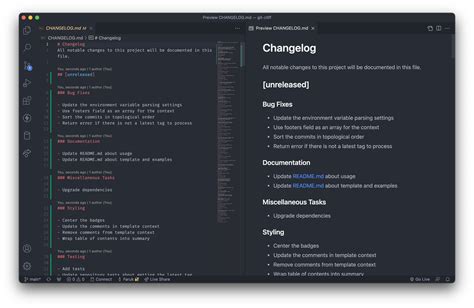Generating comprehensive and understandable changelogs for software releases can often be a painstaking task, especially when delving through numerous commit messages. Enter Git-Cliff, a remarkable tool designed to streamline this process by auto-generating changelogs directly from Git commit histories. This approach, however, has sparked a spirited debate among developers on its efficiency, practicality, and utility, shedding light on the intricacies of release documentation.
One of the most enthusiastic points of praise for Git-Cliff revolves around its potential to generate clean and organized changelogs effortlessly. Proponents like Amar-laksh are especially enamored by its interface, drawing attention to the visually appealing animations that make the tool engaging. Others, like Weinzierl, have recommended exploring similar projects by the same author, such as ratatui.rs, which notably showcases creative presentations of this kind.
Nevertheless, the primary value proposition of Git-Cliff lies in its ability to condense vast commit histories into meaningful release notes. This capability aims to alleviate concerns like those expressed by Herewulf regarding the cluttered nature of commit-based changelogs. Her complaint about including minor refactorings and trivial changes in user-facing notes demonstrates a common pain point that sophisticated tools like Git-Cliff aim to address. The tool’s focus on highlighting significant updates and filtering out the noise can enhance the clarity and usefulness of release notes.
Jochim counters the skepticism by highlighting how commits could be parsed intelligently using conventions like Conventional Commits. By employing specific patterns, such as prefixing commit messages with feat:, fix:, or refactor:, developers can ensure that only relevant changes populate the generated changelog. This methodological approach underscores how proper commit message discipline can significantly streamline the automation of changelog creation, freeing up valuable developer time for other tasks.
While skepticism remains, as demonstrated by comments like those from Keybored and Mathstuf, who question the aesthetic and practical implications of sticking to conventional commit message formats, it becomes evident that the value of such tools ultimately depends on the team’s context and discipline. For smaller, less structured projects, enforcing such conventions might indeed feel burdensome. However, for larger or more disciplined teams, these tools can systematically enrich documentation practices.
Interestingly, the discussion also pivots around the notion that while auto-generated changelogs provide a solid base, they should ideally be augmented manually. This sentiment is echoed by Lloydatkinson, who argues for the necessity of human curation to refine and polish auto-generated content. For instance, Jochim extends this thought by suggesting integrating these tools within ticketing systems to involve non-developer stakeholders in the release process, ensuring that the final product is comprehensive and accessible.
Moreover, tools like Git-Cliff facilitate a shift in responsibility for maintaining changelogs, from managers to individual developers at the time of committing. Weinzierl points out that this practice can significantly reduce the risk of omitting critical changes from the final release notes. However, it’s essential to note that while automated tools can provide a comprehensive draft, the nuanced expertise of a human editor remains irreplaceable in refining the narrative for end users.
In the grand scheme, Git-Cliff and similar tools like semantic-release and cocogitto represent a convergence of technology and process optimization, aiming to streamline software development workflows. By transforming how changelogs are generated and maintained, they promise to enhance transparency and efficiency, fostering better communication within development teams and with end users. Essentially, they encourage a disciplined approach to commit messages, which can, over time, elevate the overall quality and clarity of software project documentation.


Leave a Reply